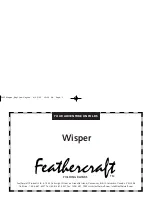
1. ******** SPECIAL SAFETY WARNINGS *******
DO NOT POWER OR SAIL THE MACGREGOR 26
WITHOUT MAKING SURE THAT THE WATER BAL-
LAST TANK IS COMPLETELY FULL.
Unless the water ballast tank is completely full, with 1200
pounds of water ballast, the sailboat is not self righting. With-
out the water ballast, the boat will not return to an upright
position if the boat is tipped more than 60 degrees, and will
capsize like most non-ballasted sailboats. Always, before
operating the boat, remove the 1" diameter vent plug lo-
cated in the compartment under the cabin access ladder, and
use your finger to make sure that the water level is no more
than 3" below the hole from which the plug was removed.
Then reinstall the plug.
MAKE SURE THE TANK VALVE NUT AND THE
PLUG ARE SECURE AND TIGHT BEFORE OPER-
ATING THE BOAT.
If the valve is not tight, water will run out of the ballast tank
if the boat tips excessively, and self righting stability will be
lost. If the 1" plug is not secure, the ballast water will spill
out into the boat if the boat tips.
DO NOT ALLOW ANY PART OF THE BOAT.
TRAILER, MAST OR RIGGING TO COME IN CON-
TACT WITH ANY SOURCE OF ELECTRICAL
POWER.
If your mast or any part of your boat or rigging comes in
contact with a power line, you could be killed or injured.
Don’t sail your boat into a power line. Don’t step your mast
into a power line, or don’t move your boat, on its trailer,
into a power line. Masts, wire shrouds, or wet fiberglass are
good conductors of electricity and can carry current directly
to you. Look up and make sure you will be clear of sources
of power before doing anything with your boat. Don’t re-
move the warning decal from your mast. It may help you
remember to look and avoid a major calamity.
If you are caught in an electrical storm, don’t touch any-
thing that is metal, including the mast, shrouds, boom, life-
lines, rudder, tiller or metal hardware. If possible, don’t touch
anything that is wet. Many experts recommend that a heavy
gauge copper wire be securely fastened to one of the shrouds
and allowed to hang in the water to carry off the electricity
from a lightning strike.
MAKE SURE THAT YOU TOW YOUR BOAT WITH A
LARGE ENOUGH CAR. CHECK WITH YOUR CAR
MANUFACTURER OR DEALER TO DETERMINE IF
THE WEIGHT OF THE BOAT AND TRAILER IS
WITHIN YOUR CAR’S TOWING CAPACITY.
LOAD YOUR BOAT SO THE WEIGHT ON THE
TRAILER HITCH IS BETWEEN 200 AND 250
POUNDS.
If the weight is less, the trailer will tend to swerve danger-
ously from side to side. If the weight is more, an excessive
load will be placed on the rear end of your car, and the trailer
will be very difficult to hitch or unhitch. To protect your
back when removing the trailer from the car, use the hitch
jack or have an adult hang on the back of the boat to take
some weight off the tongue.
NEVER LOAD THE BOAT AND TRAILER MORE
THAN THE AMOUNT SHOWN ON THE CERTIFI-
CATION DECAL NEAR THE HITCH. ON THE LEFT
(PORT) SIDE OF YOUR TRAILER (2750 POUNDS).
Remember, the maximum gross vehicle weight (G.V.W.R.)
includes the weight of the trailer as well as the weight of the
boat and all gear in the boat. You may not deduct the weight
that is carried on the hitch of the car in arriving at the
G.V.W.R. Check your state law to determine if there are any
other weight or braking requirements that must be met.
DO NOT TRAILER THE BOAT WITH ANY WATER
IN THE BALLAST TANK. THE 1200 POUNDS OF
WATER WILL SEVERELY OVERLOAD THE
TRAILER AND THE CAR.
Open the valve and drain the tank completely before
trailering. Leave the valve open when trailering.
SECURE THE POP TOP IN THE DOWN POSITION
AND CLAMP THE FOREDECK HATCH SHUT IN
ALL BUT THE MOST GENTLE OF WINDS.
Strong gusts can unexpectedly cause the boat to lean exces-
sively, possibly allowing water to enter the hatch and flood
the boat. Unsecured hatches can be blown shut, and may
injure someone on board.
BE READY TO RELEASE SAIL CONTROL LINES
(SHEETS) QUICKLY IF A GUST OF WIND CAUSES
THE BOAT TO LEAN EXCESSIVELY.
Lines should be free of kinks and knots so they will run
freely through the pulleys when it is necessary to let the
sails out quickly. Letting the lines go is your best protection
from a knockdown. For best performance and safety, keep
the boat from leaning (heeling) more than about 20 to 25
degrees.
Содержание 26
Страница 13: ......



































